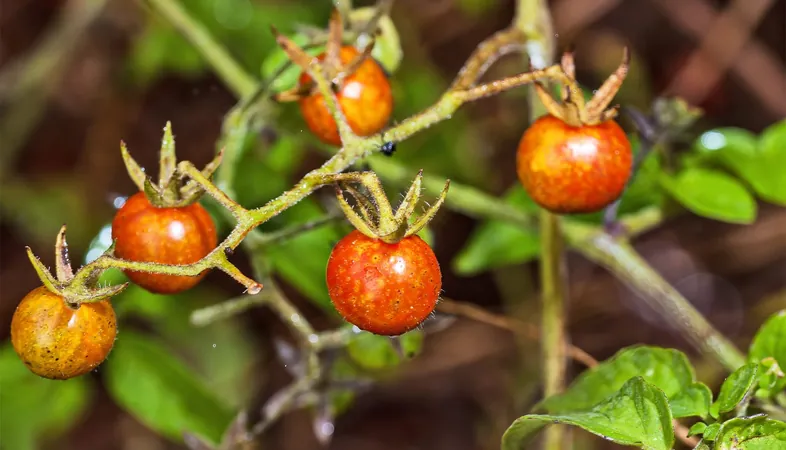
Galápagos Tomatoes Defy Evolution by Reverting to Ancient Traits!
2025-07-01
Author: Ming
In a stunning twist of nature, wild tomatoes on the youthful black-rock islands of the Galápagos archipelago are defying evolutionary norms by reverting to their primitive roots. These tomatoes are not just regressing; they're resurrecting ancient chemical defenses that disappeared millions of years ago!
These intriguing plants, descendants of South American ancestors likely transported by birds, are synthesizing a toxic molecular cocktail reminiscent of compounds found in eggplants—traits not observed in modern tomatoes for eons.
In groundbreaking research published in Nature Communications, scientists from the University of California, Riverside, dubbed this phenomenon "reverse evolution." Although a contentious term among evolutionary biologists—given that evolution is generally viewed as a one-way journey towards adaptation—this case challenges that notion. Adam Jozwiak, a molecular biochemist and lead author of the study, states, "It’s not something we usually expect, but here it is, happening in real time, on a volcanic island.'
At the heart of this chemical transformation are alkaloids, bitter molecules that serve as natural pesticides, warding off pests and diseases. While the Galápagos may be a haven for animals with few predators, the same can’t be said for plant life, highlighting the need for alkaloid production.
The research initiative originated from concerns over alkaloids in crops, which can be toxic at high levels for human consumption. By understanding how these compounds are produced, scientists aim to control their levels in edible plants.
What sets these Galápagos tomatoes apart is not just their ability to produce alkaloids but that they’re manufacturing the 'wrong' ones—those unseen in tomatoes for millions of years.
The researchers examined over 30 tomato samples from various locations across the islands. Those from the older eastern islands generated familiar alkaloids found in cultivated tomatoes, while specimens from the younger western islands were crafting a different alkaloid suite with chemical signatures akin to ancient eggplant relatives.
This striking difference hinges on stereochemistry—the arrangement of atoms in three-dimensional space can drastically affect how molecules behave. By analyzing the enzymes responsible for assembling these alkaloids, scientists found that merely altering four amino acids in one enzyme could transform modern compounds back into their ancestral forms.
The findings were no coincidence; they revealed a geographical pattern. Tomatoes on the older islands, marked by stability and biodiversity, produced contemporary alkaloids. In contrast, those on the barren western islands reverted to ancient chemistry—likely a survival mechanism in harsher conditions.
Exploring this shift further, the team employed evolutionary modeling using modern DNA to predict traits of long-extinct ancestors, confirming that these tomatoes are indeed echoing the chemical signatures of their bygone predecessors.
Labeling this process "reverse evolution" may seem audacious. Although instances of ancient traits reappearing have been recorded in other species—like snakes, fish, and bacteria—this case stands out for its clarity and precise chemical evidence.
Jozwiak adds, "Some people don’t believe in this, but the genetic and chemical evidence points to a return to an ancestral state. The mechanism is there. It happened." And if this occurrence is possible in tomatoes, who’s to say it couldn’t happen in other species, including humans, over time?
This research opens the door to a re-evaluation of evolution's flexibility. Traits long thought lost could re-emerge, and ancient genes might awaken anew. As Jozwiak succinctly puts it, "If you change just a few amino acids, you can get a completely different molecule.' The implications of this research are vast, holding the potential to engineer new medicines, enhance pest resistance, or produce less toxic food. Yet, the first step is mastering how nature achieves such remarkable feats—this study is a significant leap in that direction!




 Brasil (PT)
Brasil (PT)
 Canada (EN)
Canada (EN)
 Chile (ES)
Chile (ES)
 Česko (CS)
Česko (CS)
 대한민국 (KO)
대한민국 (KO)
 España (ES)
España (ES)
 France (FR)
France (FR)
 Hong Kong (EN)
Hong Kong (EN)
 Italia (IT)
Italia (IT)
 日本 (JA)
日本 (JA)
 Magyarország (HU)
Magyarország (HU)
 Norge (NO)
Norge (NO)
 Polska (PL)
Polska (PL)
 Schweiz (DE)
Schweiz (DE)
 Singapore (EN)
Singapore (EN)
 Sverige (SV)
Sverige (SV)
 Suomi (FI)
Suomi (FI)
 Türkiye (TR)
Türkiye (TR)
 الإمارات العربية المتحدة (AR)
الإمارات العربية المتحدة (AR)